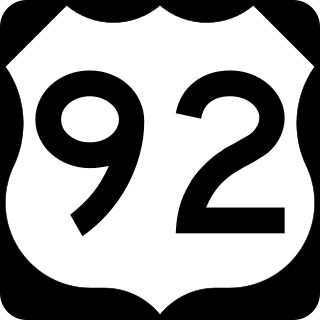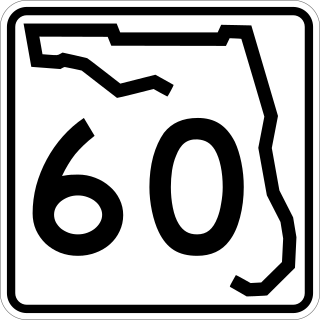
Interstate 4 (I-4) is an Interstate Highway located entirely within the US state of Florida, maintained by the Florida Department of Transportation (FDOT). Spanning 132.30 miles (212.92 km) along a generally southwest–northeast axis, I-4 is entirely concurrent with State Road 400 (SR 400). In the west, I-4 begins at an interchange with I-275 in Tampa. I-4 intersects with several major expressways as it traverses Central Florida, including US Highway 41 (US 41) in Tampa; US 301 near Riverview; I-75 near Brandon; US 98 in Lakeland; US 27 in unincorporated Davenport; US 192 in Celebration; Florida's Turnpike in Orlando; and US 17 and US 92 in multiple junctions. In the east, I-4 ends at an interchange with I-95 in Daytona Beach, while SR 400 continues for roughly another four miles (6.4 km) and ends at an intersection with US 1 on the city line of Daytona Beach and South Daytona.

U.S. Route 92 or U.S. Highway 92 is a 181-mile (291 km.) U.S. Route entirely in the U.S. state of Florida. The western terminus is at US 19 Alt. and SR 687 in downtown St. Petersburg. The eastern terminus is at SR A1A in Daytona Beach.

Interstate 275 (I-275), located in Florida, is a 60-mile-long (97 km) auxiliary Interstate Highway serving the Tampa Bay area. Its southern terminus is at I-75 near Palmetto, where I-275 heads west towards the Sunshine Skyway Bridge crossing over Tampa Bay. From that point, I-275 passes through St. Petersburg before crossing Tampa Bay again on the Howard Frankland Bridge, then continues through the city of Tampa, where it connects to an interchange with I-4 in Downtown Tampa. After the interchange, I-275 passes north through the Tampa suburbs to its northern terminus at I-75 in Wesley Chapel.
State Road 589 (SR 589), also known as the Veterans Expressway and Suncoast Parkway, is a controlled-access toll road near the Florida Gulf Coast. Maintained and operated by Florida's Turnpike Enterprise, this 68-mile (109 km) transportation corridor extends from State Road 60 in Tampa, north to State Road 44 near Lecanto. The Veterans Expressway was built to accommodate the increasing commuter traffic in the Tampa-St. Petersburg metropolitan area, with the Suncoast Parkway opening in 2001, extending from near the northern terminus of the Veterans Expressway to U.S. Route 98, with a possible northern extension to U.S. Route 19/U.S. Route 98 in Crystal River in Citrus County in the planning and development stages. As of February 28, 2022, Phase I of the extension is now open between US 98 and Florida State Road 44. Phase II, which would further extend the highway to County Road 486, is undergoing the design phase.

State Road 60 is an east–west route transversing Florida from the Gulf of Mexico to the Atlantic Ocean. The western terminus of SR 60 is at the Sunsets at Pier 60 site in Clearwater Beach. The eastern terminus is in Vero Beach near the Atlantic Coast just past State Road A1A.

The W. Howard Frankland Bridge is the central fixed-link bridge spanning Old Tampa Bay from St. Petersburg, Florida to Tampa, Florida. It is one of three bridges connecting Hillsborough County and Pinellas County; the others being Gandy Bridge and Courtney Campbell Causeway. The bridge carries Interstate 275 and is by far the most traveled of the bay's bridges.

Dale Mabry Highway is a north–south road in Tampa, Florida. The majority of its length consists of three lanes each direction plus a central turn-lane and often includes a right-turn lane. It begins at the MacDill Air Force Base entrance in South Tampa and ends by merging with US 41 just north of the Pasco County border. The highway carries multiple designations, carrying US 92 for an approximately five-mile (8.0 km) stretch between Hillsborough Avenue and Gandy Boulevard.

The Lee Roy Selmon Expressway is a 14.168-mile (22.801 km) controlled-access toll road in Hillsborough County, Florida. It connects the South Tampa neighborhood near MacDill Air Force Base with Downtown Tampa and the bedroom community of Brandon. The expressway was built in stages, opening between 1976 and 1987. An approximately 1.9-mile extension to the thoroughfare's western terminus opened to traffic on Monday, April 19, 2021.
Palma Ceia is a neighborhood located southwest of downtown Tampa, Florida in South Tampa. It is bounded by Miguel Street West of MacDill Avenue and Neptune Street East of MacDill Avenue to the north; Bay to Bay Boulevard from Dale Mabry to Himes and El Prado between Himes and the Crosstown Expressway to the south; MacDill Avenue between Neptune and San Miguel, Dale Mabry Highway between San Miguel and Bay to Bay and Himes between Bay to Bay and El Prado to the west; and the Lee Roy Selmon Expressway to the east. The street names throughout Palma Ceia are of Cuban origin, coming from streets in the old section of Havana. Historians say the most likely explanation is that Angel Cuesta, president of Cuesta-Rey cigars, shared a map of Havana with developer Thomas Palmer while discussing the area.

State Road 694 (SR 694) is an east–west route in Pinellas County, running from SR 693 in Pinellas Park to U.S. Route 92 in St. Petersburg.

State Road 616 (SR 616) is an east–west road consisting of two wide streets near Tampa International Airport; West Spruce Street, and Boy Scout Boulevard. It runs from the interchange with Veterans Expressway and George J. Bean Parkway to Dale Mabry Highway. In September 2001, the International Plaza shopping mall opened on the corner of SR 616 and West Shore Blvd.
The Tampa Hillsborough Expressway Authority (THEA) owns, operates and maintains the Lee Roy Selmon Expressway in Tampa. The Selmon Expressway is a tolled highway. The Reversible Express Lanes (REL), a highway within a highway, runs in the middle on the eastern side of the highway with two non-tolled feeder roads, Brandon Parkway in Brandon and Meridian Avenue in Tampa, providing the entrance and exit to the REL. Additionally, THEA owns and operates the Selmon Greenway, a multipurpose recreational pathway running beneath and alongside the Lee Roy Selmon Expressway.

Interstate 75 (I-75) is a part of the Interstate Highway System that runs from the Hialeah–Miami Lakes border, a few miles northwest of Miami, to Sault Ste. Marie in the Upper Peninsula of Michigan. I-75 begins its national northward journey near Miami, running along the western parts of the Miami metropolitan area before traveling westward across Alligator Alley, resuming its northward direction in Naples, running along Florida's Gulf Coast, and passing the cities of Fort Myers, Punta Gorda, Venice, and Sarasota. The freeway passes through the Tampa Bay area before turning inward toward Ocala, Gainesville, and Lake City before leaving the state and entering Georgia. I-75 runs for 471 miles (758 km) in Florida, making it the longest Interstate in the state and also the longest in any state east of the Mississippi River. The Interstate's speed limit is 70 mph (110 km/h) for its entire length in Florida.
The I-4/Selmon Expressway Connector is a controlled-access toll road that between I-4, the Lee Roy Selmon Expressway (SR 618), and the Port of Tampa east of Ybor City in the city of Tampa, Florida. It primarily comprises four parallel one-way roadways west of 31st Street, continuously elevated over local streets, railroads, and vacant land, with a SunPass/toll-by-plate electronic toll gantry spanning the structure near the southern end. All movements were opened to traffic on January 6, 2014, and the direct connections to the Port of Tampa are signed as Truck Routes.

State Road 569 is a short state road located entirely in Tampa, Florida. Also known as 39th Street south of 11th Avenue and 40th Street north of it, it is approximately 1.3 miles (2.1 km) long.

U.S. Route 301 in Florida runs from the Sarasota-Bradenton-Venice, Florida Metropolitan Statistical Area northeast to the Greater Jacksonville Metropolitan Area. The road is a spur of U.S. Route 1, which it intersects in Callahan.
There have been plans in Florida for expressways, but some were never constructed due to financial problems, community opposition and environmental issues.

South Tampa is a region in the city of Tampa that includes the neighborhoods of Beach Park, Ballast Point, Bayshore Beautiful, Bayshore Gardens, Bayside West, Belmar Shore, Davis Islands, Port Tampa, Fair Oaks-Manhattan Manor, Golfview, Hyde Park, New Suburb Beautiful, Virginia Park, Palma Ceia, Rattlesnake Gandy-Sun Bay South, South Westshore, parts of Sunset Park and Courier City-Oscawana. MacDill Air Force Base is also included. The region represents District 4 of the Tampa City Council. The ZIP Codes serving the area are 33606, 33608, 33609, 33611, 33616, 33621, and 33629
MetroRapid is an express bus system in Tampa, Florida. Operated by Hillsborough Area Regional Transit, it incorporates some bus rapid transit features. Currently, there is only one line in operation, the North-South line, with an East-West line in the planning phase. Subsequent lines could open depending on the success of the two initial lines.
Highway revolts have occurred in cities and regions across the United States. In many cities, there remain unused highways, abruptly terminating freeway alignments, and short stretches of freeway in the middle of nowhere, all of which are evidence of larger projects which were never completed. In some instances, freeway revolts have led to the eventual removal or relocation of freeways that had been built.
















